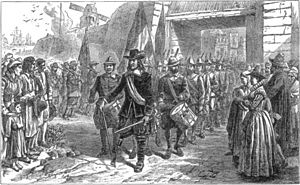Articles of Surrender of New Netherland facts for kids
The Articles of Capitulation on the Reduction of New Netherland was an important document signed on September 29, 1664. It was an agreement for the Dutch Republic to surrender its colony, New Netherland, to the Kingdom of England. This event marked a big change in the history of what would become New York.
The leader of New Netherland, Peter Stuyvesant, agreed to the surrender two days later. The English forces were led by Richard Nicolls, who then became the first Governor of the new Province of New York.
Johannes de Decker, a lawyer for Peter Stuyvesant, was the main person who negotiated for the Dutch side. The agreement was signed on an English ship in the harbor. The articles included many important rights and freedoms for the people living in New Netherland. These rights were like an early bill of rights. Many of these ideas later appeared in the Declaration of Independence and the American Constitution.
Twelve people signed the document. Six represented England and the New England colonies. The other six represented the Dutch Council of New Netherland, the West India Company, and the people of New Netherland. The English mostly followed the terms of the agreement during their takeover of New Netherland.
Contents
Why Did New Netherland Surrender?
In 1664, England and the Dutch Republic were rivals. England wanted to control the valuable port of New Amsterdam and the surrounding Dutch territory. English warships arrived in New Amsterdam's harbor, demanding the Dutch surrender. Despite Peter Stuyvesant's initial desire to fight, the citizens and his council convinced him to negotiate. They wanted to avoid bloodshed and ensure their rights were protected.
Who Signed the Agreement?
The signing of the Articles of Capitulation was a major event. It involved representatives from both the English and Dutch sides. Each person played a role in deciding the future of New Netherland.
English Signatories
The English side included officers and representatives from other English colonies:
- Sir Robert Carr (an officer)
- George Cartwright (an officer)
- John Winthrop (from Connecticut)
- Samuel Willys (from Connecticut)
- Thomas Clarke (from Massachusetts)
- John Pincheon (from Massachusetts)
Dutch Signatories
The Dutch side included important officials from New Netherland:
- Johannes de Decker (from the Council of New Netherland)
- Nicholas Verleet (from the Council of New Netherland, focused on trade)
- Samuel Megapolensis (from the Council of New Netherland, a medical doctor)
- Cornelius Steenwyk (a burgomaster, or city leader)
- Oloff Stevens van Cortlandt (an old burgomaster)
- James Cousseau (a schepen, or magistrate)
What Did the Articles Say?
The Articles of Capitulation were a detailed agreement. They laid out the rules for the transfer of power from the Dutch to the English. These rules were very important for the people living in New Netherland. They helped ensure a smooth change and protected many rights.
Here are some of the key points from the Articles:
- Property Rights: People could keep their lands, houses, and goods. They could also sell them if they wanted to move.
- Freedom to Move: Residents had a year and six weeks to decide if they wanted to move away. If they did, they could take their families and belongings.
- Religious Freedom: The Dutch people could continue to practice their religion freely. This included their divine worship and church rules.
- No Forced Military Service: Dutch people or ships would not be forced to fight in wars against any nation.
- No Quartering of Soldiers: Soldiers would not be housed in private homes in Manhattan without payment.
- Dutch Customs: The Dutch people could keep their own customs regarding inheritances.
- Official Records: Important public documents and records would be kept safe.
- Trade: Dutch ships could continue to come to New Netherland and trade for six months after the surrender.
- Military Terms: Dutch soldiers could march out with their weapons and flags. If they wanted to stay, they could receive land.
- Future Return: The articles even mentioned that if England and the Netherlands later agreed, the territory could be returned to the Dutch. This shows how complex international relations were.
These articles were very important. They helped shape the future of New York and showed how rights could be protected even during a change of power.
See also


